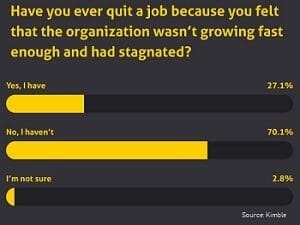I am fortunate in having spent most of my career working at fast-growing and dynamic businesses. In this kind of situation, the jobs people do tend to constantly expand, and they are called upon to grow with the role. That is challenging and involves a lot of rapid learning, but it is also exciting. In my experience building and maintaining high performance teams, when people feel intellectually stimulated at work they are actually more likely to be engaged and motivated. It is when they are bored and under-utilized that they take that call from the headhunter.
 With this, it was no surprise to me when a recent Kimble survey revealed that most employees are very keen on working for expanding firms – almost a quarter said they had left a job because the company wasn’t growing fast enough. But once you have hired dynamic new employees to come and work in the “deep-end” environment of a growing business, how do you help them to stay afloat?
With this, it was no surprise to me when a recent Kimble survey revealed that most employees are very keen on working for expanding firms – almost a quarter said they had left a job because the company wasn’t growing fast enough. But once you have hired dynamic new employees to come and work in the “deep-end” environment of a growing business, how do you help them to stay afloat?
Reach out before they start
Engaging with new employees doesn’t need to wait until their first day at work. The period between interviewing someone, offering them a job, signing the paperwork and their first day in the office varies, but it is often around a month. Potentially, the idea of what they liked about your culture has faded in this time. Sometimes, even after what seemed like a great match at the interview, the person seems unprepared when they arrive.
At a previous company I founded, we figured that we needed to capture their hearts and minds and get them to work in our “empowered” way within 60 days of starting (or 90 days from being hired). So, we deliberately set out to connect to new employees as early as possible. We had a 30/60/90-day plan.
In the period until they joined, we invited them to company events and socials. People at this stage of transition can engage on social media or through in-house chat streams. They can be invited to join fantasy football leagues, etc. This makes them feel part of the company before they join and keeps that sense of excitement and anticipation going.
We set up a program to introduce people into our company culture as soon as they joined in the first 30 days. This was always run by one of the two founders and was of very high importance. We would invite new hires to attend the first session within the first month.
We also cycled all of the existing employees through this course over time – it was a chance for them to think about how the company was evolving and how what was expected of them was changing because we were no longer a small company. So, we had a nice mixture of new starts and old hands. The group was never more than 10 people, and it was an intimate and friendly setting for discussion. We would finish with a social dinner and drinks. It was a great opportunity to break the ice and to share our values.
Provide pointers to navigate the culture
One of my key cultural precepts would be, “Always keep a sense of perspective.” What we do is important but we are not doing open-heart surgery, so you are not about to kill anyone! It’s important to encourage people to try things and make mistakes.
Another one is, “Stay focused on the customers.” I want everyone to concentrate on outward-facing activity – not to get sidetracked by internally-focused priorities that don’t add value.
A third is, “Keep on developing your skills and talents.” Everyone should be adding at least one line to their resume every year. That’s a challenge to both the individual and the company. When people have this expectation, it means if the company is not providing opportunities for them to continue to grow, they will leave.
With this early start, people would already have a feel for who we were. We’d then effectively re-interview them and agree on objectives for the next 30 days, by which time they would have been inducted into our culture and understand what we wanted from them. At the next 30 days, we would go through the process again.
This produced a big improvement in onboarding new hires in our ways of working. But also, it meant we got their feedback at an early stage if they were not feeling supported or empowered enough and we could adjust accordingly.
We want solutions
You must encourage people to suggest solutions and not create problems. When someone brings a suggestion to me, I feel it is my job as a manager to either go with that solution or disagree – but not to procrastinate. In a culture of accountability, if the person isn’t actually 100% sure their idea will work they will say “Hang on a minute” and voice those reservations, allowing you to consider it more deeply. But if their solution was a definite fix for the problem they identified, they will feel empowered because it was immediately acted upon.
If you do disagree with their idea you can simply ask: “What were the facts upon which you based that decision?” Perhaps they didn’t have all the facts at their disposal. Alternatively, it could be that they have information which you were not aware of. Either way, that is a positive way to embark on the process of reviewing a decision.
This is much better than creating a culture where people are reliant on senior managers to make every decision and to solve every problem. To become and stay agile, responsibility in a growing company must be decentralized. If every decision is pushed up to the C-suite, bottlenecks arise; issues don’t get dealt with swiftly and they can snowball.
Encouraging people to make mistakes and try things is key. Where people have the autonomy to actually make decisions, they will develop skills more quickly and contribute more effectively.
Nobody gets it right all the time
Good decision-making isn’t the same as getting everything right all the time. People will get things wrong and then learn from that. Of course, sometimes just taking a throw at the office dartboard or rolling a dice to make a decision would get you to the right answer, just by chance. However, that would not be a good way to run your business in the long run! Equally, even a great decision-making process is going to come up with the wrong answer from time to time. But it will lead to a more consistent outcome.
So, institute a feedback loop or review process which focuses on the quality of the decision-making process and not the outcome. Good decision-making tends to be supported by data, and based on trends, rather than single points of information.
Offer support without taking over
It is great to have a culture where people feel they have autonomy and can get on with their jobs. But if someone is struggling with their expanding role, you do want them to feel supported. Simply asking, “Would you like me to help you with that?” is a way of offering assistance without taking over.
In a positive culture, where people are engaging at the top of their game, they will be more likely to come up with solutions rather than simply reporting problems. That’s a win-win for the company which will benefit from innovative thinking and fresh ideas.
In conclusion, a dynamic and expanding business is a place where people have the chance to take on new opportunities and to drive change. This is likely to be a challenging environment, but hopefully it will also be exciting and inspiring.
